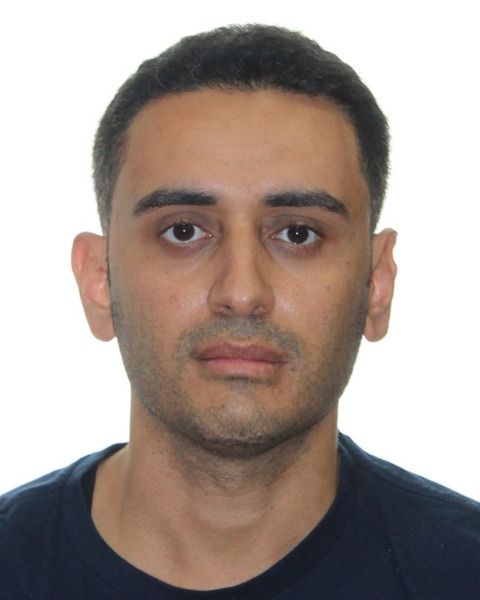Neonatal Clinical Trials
Category: Abstract Submission
Neonatal Clinical Trials I
433 - Ultrasonographic assessment of diaphragmatic function in noninvasive neurally adjusted ventilation (NIV-NAVA) Versus nasal intermittent positive pressure ventilation (NIPPV) in preterm infants
Saturday, April 23, 2022
3:30 PM - 6:00 PM US MT
Poster Number: 433
Publication Number: 433.223
Publication Number: 433.223
Mohamed Elkhouli, The Hospital for Sick Children, Toronto, ON, Canada; liran Tamir-Hostovsky, Sheba medical Center, Kyriat Ono, HaMerkaz, Israel; Jenna Ibrahim, N/A, Toronto, ON, Canada; Adel Mohamed, University of Toronto Temerty Faculty of Medicine, Toronto, ON, Canada; Nehad Nasef, Faculty of Medicine, UNiversity of Mansoura, Egypt, Mansoura, Ad Daqahliyah, Egypt

Mohamed Elkhouli, MD
fellow
The Hospital for Sick Children
Toronto, Ontario, Canada
Presenting Author(s)
Background: Invasive and Non-Invasive NAVA (NIV-NAVA) are relatively new ventilation modes that use the electrical activity of the diaphragm to synchronize with patient’s timing, duration, and magnitude of each breath. However, no studies have yet compared the diaphragmatic function in preterm infants managed with NIV-NAVA to infants managed with (NIPPV).
Objective: The primary and secondary aims were to assess diaphragmatic function [diaphragmatic excursion (DE) and diaphragmatic thickness fraction (DTF)] and lung aeration for preterm infants ( < 30 weeks’ gestation) on NIV-NAVA compared to infants on NIPPV.
Design/Methods: This prospective study enrolled infants < 30 weeks’ gestation who were on NIV-NAVA or NIPPV for > 24hrs. Measurements of right-side DE and DTF using M-mode and LUS score (LUSS) were performed. Diaphragmatic excursion was measured as the perpendicular distance between the most caudal point of the liver at end-expiration and inspiration. Diaphragmatic thickness was measured at the zone of apposition as the distance between pleural and peritoneal layers during end-inspiration and expiration. DTF was calculated as: [(inspiratory thickness - expiratory thickness)/expiratory thickness] x 100. The values of three consecutive respiratory cycles were averaged. DE, DTF, and LUSS were calculated in blinded fashion by individuals who were not aware of the patient’s group (NIV-NAVA vs NIPPV). Measurements and LUSS of infants were compared between groups. Statistical analyses were conducted using SPSS software.
Results: We enrolled 40 babies, 20 in the NIV-NAVA group and 20 in the NIPPV group. Baseline characteristics and respiratory parameters at the time of the scan showed no significant difference between groups as described in Table 1. DE was significantly higher in NIV-NAVA group with a mean SD 4.7 (1.5) vs 3.5(0.9) in NIPPV group, p=0.007. Additionally, the mean (SD) of DTF for the NIV-NAVA group was 81.6 (30) vs 78.2 (27) for NIPPV group [P= 0.71]. Both groups showed high LUSS which reflects poor lung aeration however, no significant difference between the groups [12.8 (2.6) vs 12.6 (2.6) P= 0.8] was noted.Conclusion(s): Our study is the first to suggest that in infants < 30 weeks’ gestation, NIV-NAVA was associated with improved diaphragmatic excursion compared to NIPPV. Further studies with larger sample size are needed.
Mohamed Elkhouli CV 2021.pdf
Table 2: Diaphragmatic function and Lung Ultrasound severity scoreWhatsApp Image 2022-01-02 at 2.58.30 PM.jpeg
Objective: The primary and secondary aims were to assess diaphragmatic function [diaphragmatic excursion (DE) and diaphragmatic thickness fraction (DTF)] and lung aeration for preterm infants ( < 30 weeks’ gestation) on NIV-NAVA compared to infants on NIPPV.
Design/Methods: This prospective study enrolled infants < 30 weeks’ gestation who were on NIV-NAVA or NIPPV for > 24hrs. Measurements of right-side DE and DTF using M-mode and LUS score (LUSS) were performed. Diaphragmatic excursion was measured as the perpendicular distance between the most caudal point of the liver at end-expiration and inspiration. Diaphragmatic thickness was measured at the zone of apposition as the distance between pleural and peritoneal layers during end-inspiration and expiration. DTF was calculated as: [(inspiratory thickness - expiratory thickness)/expiratory thickness] x 100. The values of three consecutive respiratory cycles were averaged. DE, DTF, and LUSS were calculated in blinded fashion by individuals who were not aware of the patient’s group (NIV-NAVA vs NIPPV). Measurements and LUSS of infants were compared between groups. Statistical analyses were conducted using SPSS software.
Results: We enrolled 40 babies, 20 in the NIV-NAVA group and 20 in the NIPPV group. Baseline characteristics and respiratory parameters at the time of the scan showed no significant difference between groups as described in Table 1. DE was significantly higher in NIV-NAVA group with a mean SD 4.7 (1.5) vs 3.5(0.9) in NIPPV group, p=0.007. Additionally, the mean (SD) of DTF for the NIV-NAVA group was 81.6 (30) vs 78.2 (27) for NIPPV group [P= 0.71]. Both groups showed high LUSS which reflects poor lung aeration however, no significant difference between the groups [12.8 (2.6) vs 12.6 (2.6) P= 0.8] was noted.Conclusion(s): Our study is the first to suggest that in infants < 30 weeks’ gestation, NIV-NAVA was associated with improved diaphragmatic excursion compared to NIPPV. Further studies with larger sample size are needed.
Mohamed Elkhouli CV 2021.pdf
Table 2: Diaphragmatic function and Lung Ultrasound severity scoreWhatsApp Image 2022-01-02 at 2.58.30 PM.jpeg
